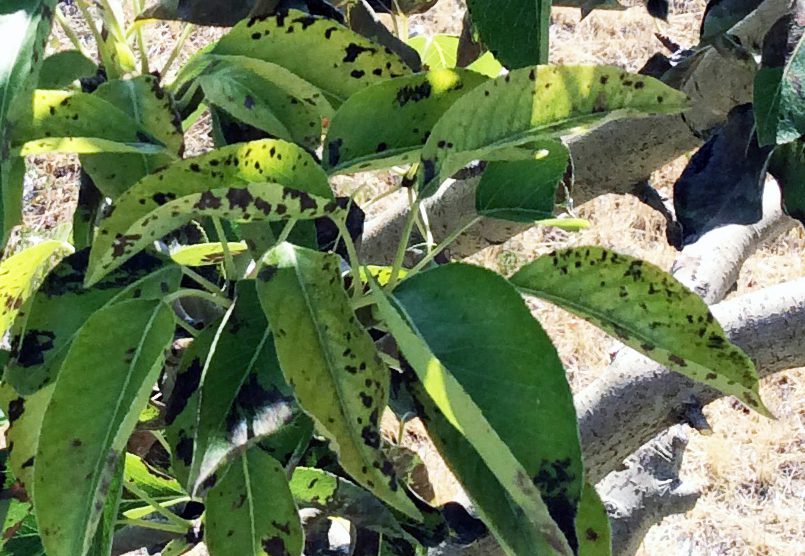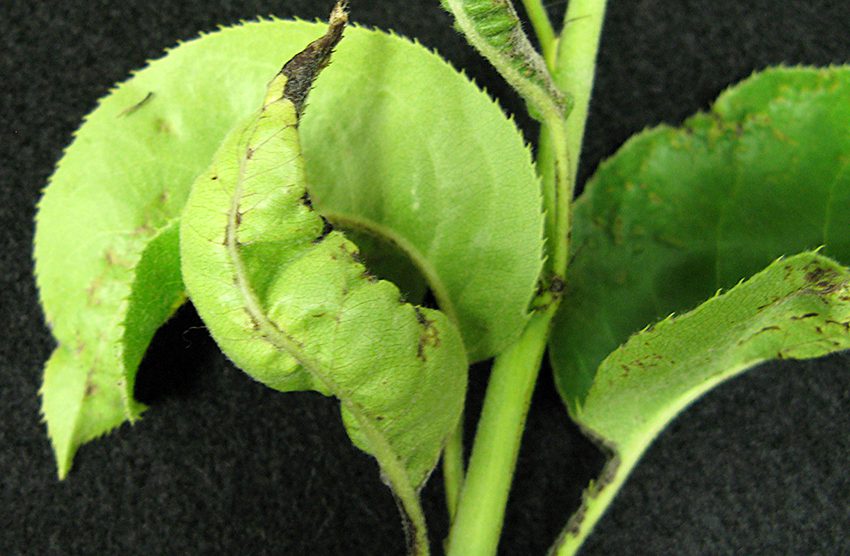In this Issue
- Codling moth: updated dates
- San Jose scale: time to treat second generation crawlers
- Pear psylla: injury has been evident for a few weeks
- Spider mites on pear: injury on foliage is different
- White apple leafhopper: nymphs present now
- Peach twig borer: updated dates
- Iron deficiency: apply foliar sprays and/or get nutrient analysis
- Earwigs: use insecticide or traps to reduce populations
- Western cherry fruit fly: post-harvest cleanup
- Walnut husk fly: peak hatch coming up
- Books for Sale: Intermountain Tree Fruit Guide and Beneficial Insects of Utah
APPLE, PEAR
Codling Moth
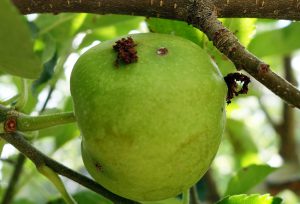
View a pdf of the spray timing table. Be sure to read the instructions at the top of the page, for how to read the table. (Note: some dates are in italics because they are past dates.)
Except for the coldest areas (Cache, Wasatch counties) all other areas of northern Utah are approaching the later portion of second generation egg hatch, with the end occurring in early to mid-August. The start of the third generation egg hatch will only be a few days later. Therefore, it is important to maintain protection of fruits regularly until September 15, or harvest (whichever is earlier). (Mid-September is the time when the eggs stop hatching due to shorter day-lengths.)
San Jose Scale
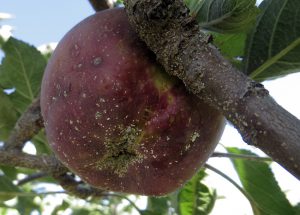
San Jose scale will have a second emergence of crawlers, coming up soon in many areas. This pest is usually treated primarily with the dormant oil spray and with treatment of the first crawler emergence. But if you have a heavy infestation, or missed the window for the first emergence, consider a treatment for the timing below.
One treatment is all that is necessary, with 1% horticultural oil for residential application (evening or early am to avoid 85+ temps) or with Esteem, Sivanto Prime, or Centaur (commercial application).
- Box Elder, Davis, Utah: July 24 – 27
- Cache: August 5 – 9
- Iron: July 24 – 28
- Salt Lake: July 23 – 25
- Tooele: July 25 – 29
- Wasatch: August 14 – 19
Pear Psylla
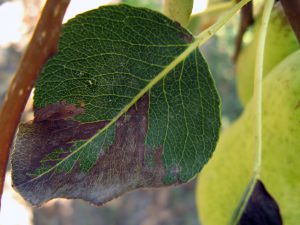
If you had not noticed the presence of pear psylla this spring, damage is evident now (and has been for a few weeks). This insect is active from spring to fall, and if left unchecked, can build to damaging levels. As they feed (mostly on the undersides of leaves), they suck plant sap and excrete copious honeydew. In addition their feeding kills the plant tissue, resulting in what looks like scorched foliage.
At this point in the growing season, all life stages can be found, including adults, eggs, newly-hatched nymphs, and older nymphs. The best timing for treatment is in spring, but if necessary, treat now to avoid further population buildup.
Treatment
- Residential: Ortho Flower, Fruit, and Vegetable, or horticultural oil (1%; apply when temperatures are below 85F).
- Commercial growers can use Actara, Admire Pro (or generics), Agri-Mek, Assail, or Delegate. Click here for more information.
Spider Mites on Pear
Spider mites are tiny organisms that feed on the undersides of the leaves and require a hand lens to see. In the last issue, we wrote about spider mites on apple, peach, and cherry. Spider mites can also affect pear, but the symptoms are much different.
Pear leaves are affected by even a small amount of mite feeding. Leaves will turn a blotchy dark brown to black, especially if there is heavy feeding over a short period of time. In addition, new foliage may also be affected, even if mites are not present. This foliar damage is related to reduced water content of leaves. It may resemble fire blight or pear psylla feeding. Mite injury is more evenly spread through the tree, and lacks the the typical shepherd’s crook symptom associated with fire blight.
Other problems with spider mite feeding on pear include reduced fruit set the following year, reduced fruit size, and increased pre-harvest fruit drop. In addition, fruit finish may be affected by late summer infestations. The following varieties are listed from highest to lowest susceptibility: `Anjou’, `Bosc’, `Bartlett’, and `Comice’.
The recommended action threshold for pears is very low: an average of 1 spider mite per leaf.
Treatment
- Backyard growers can use 1% oil (of any type). Be sure to cover bottoms of leaves. A second application 1 week later may be warranted. Apply at night when temperatures fall below 85F to prevent oil from damaging foliage.
- Options for commercial growers: click here.
White Apple Leafhopper
Where present, feeding damage from the second generation of leafhopper nymphs can now be seen on the foliage. Nymphs are active mainly on the undersides of leaves. If your trees had a high population of the first generation, now would be a good time to treat to prevent a nuisance of adults during harvest. Nymphs are easier to treat than the adults because they are less mobile. Adult activity will become very noticeable by late August.
Note that feeding on the foliage will not affect apple yield or tree health.
Treatment
- Backyard growers can use 1% oil, insecticidal soap, Ortho Fruit, Flower, and Vegetable (containing acetamiprid), Safer BioNeem
- Options for commercial growers: click here.
PEACH/NECTARINE, APRICOT, PLUM, CHERRY, WALNUT
Peach Twig Borer
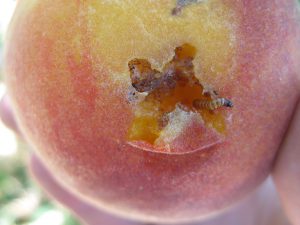
View a pdf of the spray timing table. Be sure to read the instructions at the top of the page, for how to read the table. (Note: some dates are in italics because they are past dates.)
Fruit infections are most common in commercial orchards rather than backyard trees.
Most northern Utah locations are in the midst of 2nd generation egg hatch. However, depending on last years’ damage you may be able to get away with one spray (on the appropriate date) per generation. But keep in mind that the warmer temperatures we have been experiencing will speed up egg hatch and larval development, and if you are harvesting peaches late into August and/or early September, you may need to apply a second application for each generation to protect the ripening fruit.
Treatment
Residential:
- What you are using for codling moth and/or cherry fruit fly can also be used for peach twig borer (treat only if this pest was a problem last year).
- Conventional options include Ortho Flower, Fruit, and Vegetable; Spectracide Triazicide; GardenTech Sevin
- Organic options include products containing spinosad; Safer BioNeem; Safer End All plus Neem; Ortho Fruit Spray or other products containing pyrethrins.
Commercial:
- If harvest has begun, select a material that has a shorter pre-harvest interval, such as Assail, Intrepid (7-day PHI), or Entrust (1 day PHI).
- Options for can be found here for peach, and here for apricot.
Iron Deficiency
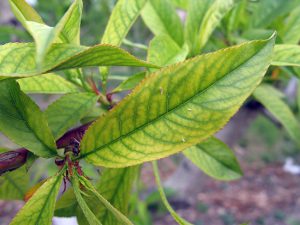
Iron chlorosis is common every year. The problem is not caused by a lack of iron in the soil, but rather the soil pH (which ranges from 7.5 to 8.5). In high pH, iron is insoluble, and therefore not available for root absorption. Because irrigation water is also very alkaline, trying to manage iron deficiency by reducing soil pH is impossible.
Iron deficiency is exacerbated by frequent springtime irrigation, prolonged soil wetness, or an uneven root to shoot ratio. Iron is a nutrient necessary for the formation of chlorophyll. Iron-deficient leaves have interveinal chlorosis (yellowing between veins). In severe symptoms, leaves may show blackened scorching, curling, or premature drop. Some trees are genetically more susceptible to nutrient deficiencies than others.
To prevent or treat iron deficiency, chelated iron should be applied to the soil in spring before budbreak. The best form of chelated iron to use is EDDHA, sold as Sequestrene or Miller’s Ferriplus.Usually one application is good for the entire season, but must be repeated again the following spring. To get the iron to the roots, it may be applied in trenches dug within the root zone or in soil plugs around the drip line.
One reader of our pest advisories has had excellent success with Baicor Iron Tree Treats, (made locally). He recommends, “Drill 3/8-inch holes 12 inches above ground in tree trunk. Insert iron cylinders and cover with grafting wax. $23 for 15 capsules.”
Later in the season, foliar iron sprays (0.1%) with a spreader-sticker provide quick results but must be reapplied at approximately 10- to 21-day intervals. The drawback of foliar sprays is that staining of fruit can occur.
To be sure of the correct nutrient deficiency, the USU Analytical Lab (435-797-2217) can test foliar and soil samples. July is an excellent time to get foliar nutrient analysis in preparation for next year’s nutrition program.
Earwigs
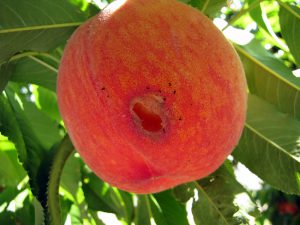
Earwigs are a perennial problem of peaches throughout northern Utah. Even though July has been very dry, the orchard environment is conducive to earwigs: irrigated ground, plenty of food, and humid cover. Once fruit softens, earwigs chew deep pits into the fruit flesh. They can also enter fruits through existing openings or cracks. Their feeding introduces bacteria and decay fungi that can render the fruit inedible.
Earwig damage is easy to diagnose because they leave behind black dots of excrement on the fruit surface.
To manage earwigs, use a variety of options:
- Trap regularly. Options are: cat food or tuna cans, with 1/2-inch of fish or bacon oil in the bottom; rolled-up newspaper; rolled up corrugated cardboard; bamboo sticks; or short pieces of hose. Place traps on the soil or wrapped around the tree trunk and empty traps into soapy water, or change them out, daily. Continue until you are no longer catching earwigs.
- Remove refuge sites. Keep mulch away from trees, remove weedy growth or groundcovers from the base of trees. Remove tree suckers or any limbs touching the ground. Remove loose bark on fruit trees where earwigs can hide.
- Pick fruits as soon as they start to ripen.
- Insecticides. Spinosad kills earwigs when they feed on it. It can be used either as a spray (many brands) or bait sprinkled at the base of trees (Sluggo Plus). (In this method, the bait must be used before the earwigs enter the tree. Otherwise, sprinkle bait in tree crotches.) Carbaryl (Sevin, others) can also be used, applied to the tree trunk and scaffold limbs, but again, it must be applied as soon as earwigs are starting to enter the tree. Both options have shown good control for earwigs, and have short PHI’s.
Western Cherry Fruit Fly Post-Harvest
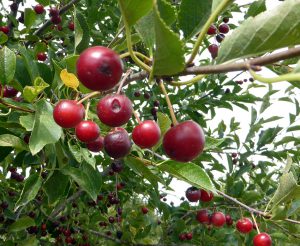
Cherry fruit fly activity peaks AFTER harvest, and untreated fruit that remain on the tree represent a source for infestation the following season. In commercial orchards, apply an insecticide such as imidacloprid (Admire/Provado, or generics) within seven days after harvest to reduce fly populations for the following year, especially in orchards with high post-harvest catches. Dimethoate plus 1% oil is another option.
For backyard trees, please remove and destroy all fallen fruit, and if possible, pick your cherry trees clean to remove egg-laying sites for late-emerging fruit flies. Please play your role in keeping your trees clean of this pest that can devastate a commercial growers’ crop.
Walnut Husk Fly
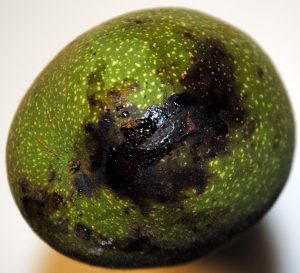
Walnut husk fly peak emergence will occur in early to mid-August. Keep nuts protected until a month before harvest. Black, Japanese, and English walnuts are all hosts for the husk fly. (Note that peach and apricot are also sometimes attacked, and if they were last year, there is a chance of attack again this year.)
Treatment
Options for residential growers:
- Peach, Apricot: Sprays for peach twig borer will also target walnut husk fly. Otherwise, a product containing spinosad (many brands) is an excellent option for both conventional and organic production.
- Walnuts: Spinosad can also be used on walnuts, and should be repeated every 10 days, ending up until one month before harvest.
Options for commercial producers:
- Peach, Apricot: from the USU commercial spray guide
- Walnut: from the Pacific Northwest handbook
OTHER INFO
Books for Sale
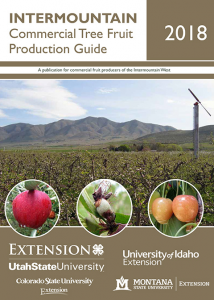 Intermountain Tree Fruit Production Guide: Commercial fruit producers growing apple, pear, peach/nectarine, cherry, apricot, and plum will find the Intermountain Tree Fruit Production Guide invaluable. Fourteen chapters cover IPM methods, special pest management programs such as mating disruption, insect and disease descriptions with color images, organic management, thinning, irrigation, nutrition, and comprehensive spray recommendations based on crop stage and pest.
Intermountain Tree Fruit Production Guide: Commercial fruit producers growing apple, pear, peach/nectarine, cherry, apricot, and plum will find the Intermountain Tree Fruit Production Guide invaluable. Fourteen chapters cover IPM methods, special pest management programs such as mating disruption, insect and disease descriptions with color images, organic management, thinning, irrigation, nutrition, and comprehensive spray recommendations based on crop stage and pest.
197 pages; spiral-bound, with UV protected cover; $12
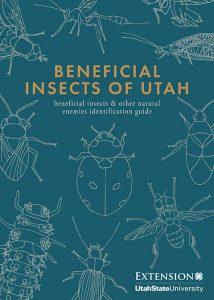 Beneficial Insects of Utah: Beneficial organisms are key to a healthy garden or farm. This book, written by USU Extension IPM team members, Cami Cannon and Marion Murray, includes hundreds of full-color images of over 60 beneficial predators, parasites, and pathogens that attack plant pests. Each entry is written in short, concise language, and includes a description, where and when it can be found, and how to conserve it.
Beneficial Insects of Utah: Beneficial organisms are key to a healthy garden or farm. This book, written by USU Extension IPM team members, Cami Cannon and Marion Murray, includes hundreds of full-color images of over 60 beneficial predators, parasites, and pathogens that attack plant pests. Each entry is written in short, concise language, and includes a description, where and when it can be found, and how to conserve it.
98 pages; spiral-bound; $6

